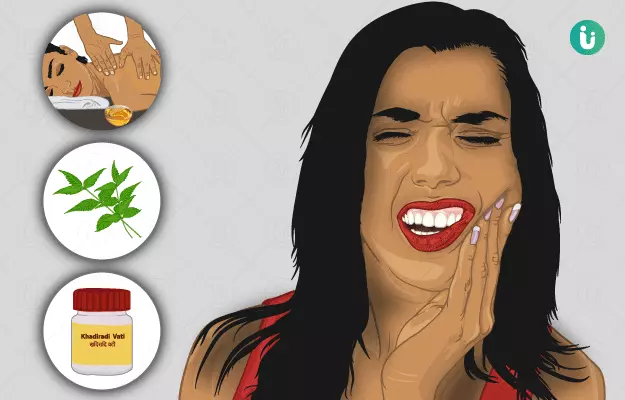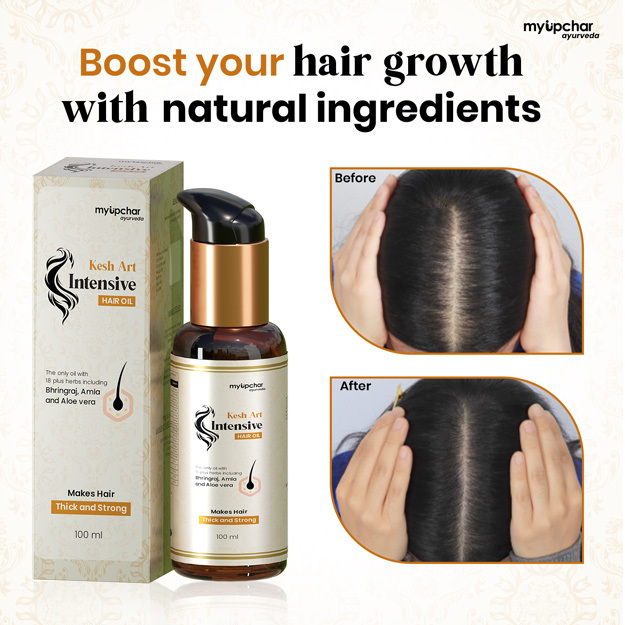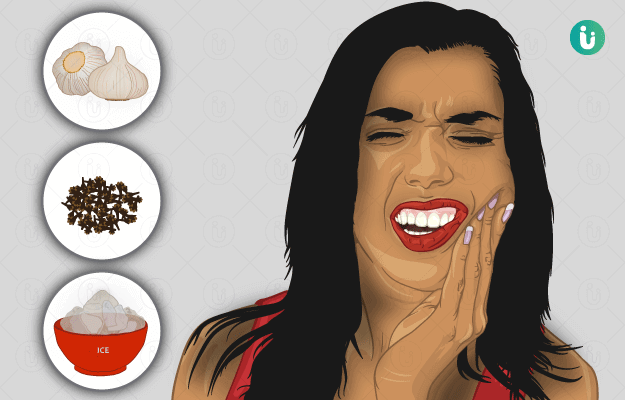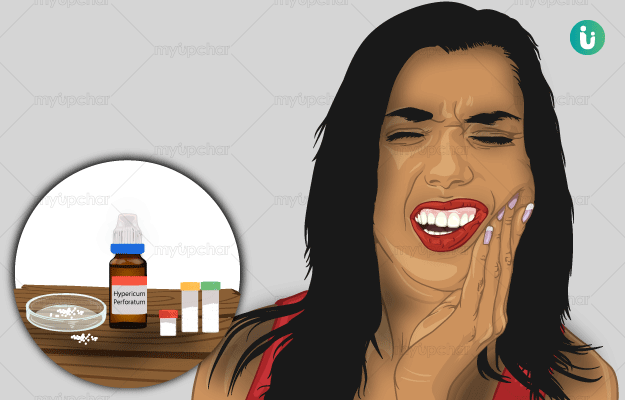A toothache, referred to as dantashula in Ayurveda, is a common symptom faced by a wide range of population. There are numerous conditions and different types of danta rogas (tooth diseases) which can cause a toothache. The exact treatment of a toothache involves identification of the cause and then using appropriate Ayurvedic therapy to manage the condition.
Ayurveda describes various therapies, herbs and medicines to manage a toothache. The Ayurvedic treatments for a toothache include abhyanga (oil massage), gandusha (oil pulling), kavala (gargling) and lepa (coating the affected body part with medications). Herbs used for the management of a toothache are nandi pushpa (East Indian rosebay), chitraka (leadwort), lavang (clove), neem, hingu (asafoetida) and tulsi (holy basil). The commonly used Ayurvedic medicines to treat a toothache are jatipatradi gutika, yavanadi churna, khadiradi vati and dashanasanskar churna.
- Ayurvedic view of toothache
- Ayurvedic treatment for toothache
- Ayurvedic herbs and medicines for toothache
- Dietary and lifestyle changes for toothache patient as per ayurveda
- How effective are ayurvedic medicines and treatments for toothache
- Side effects and risks of ayurvedic medicine and treatments for toothache
- Takeaway
Ayurvedic view of toothache
Ayurveda describes different types of diseases that may lead to a toothache. Danta rogas and dantamula rogas (diseases of gums) are the common causes of a toothache. The different types of danta rogas are:
- Khalivardhana (wisdom tooth): Eruption of the wisdom tooth usually occurs between the age of 17 to 21 years of age and it is known to cause intense pain.
- Krimi danta (dental caries): Vitiation of vata dosha causes the formation of a black cavity inside the teeth. It leads to the loosening of the teeth along with inflammation, discharge and acute pain.
- Danta harsha (sensitivity in the tooth): The inability of the teeth to bear cold along with a sensitivity to wind, rough and acidic substances.
- Danta sharkara: It is the deposition of a hard and insoluble substance (plaque), especially in the junction between teeth and gums.
The different types of dantamula rogas are as follows:
- Dantapupputaka (gumboil): It is a boil that appears at the root of the teeth. It is associated with intense inflammation, which causes pain.
- Dantaveshta (pyorrhoea): Pyorrhoea is characterised by a discharge of blood and pus from the roots of teeth. It also causes bad breath and loosens teeth.
- Saushira (gingivitis): Gingivitis is marked by inflammation and pain in the gums along with recession of the gum line. It also loosens teeth
Ayurvedic treatment for toothache
- Abhyanga
- Abhyanga is a medicated massage that is be done regularly on the affected area. It is mainly done to introduce medicinal substances in the body through skin or dermis. It delays the process of ageing and relieves tiredness. Abhyanga also lowers the excess vata, which is responsible for the pain and inflammation in teeth and gums.
- Manjistha (Indian madder) and honey are used to perform abhyanga for relieving pain in case of a toothache. Massaging teeth multiple times a day using purified lac can also aid in relieving toothache.
- Gandusha
- In this procedure, the mouth is filled completely with a liquid or oil (infused with the properties of herbs) such that it doesn't allow movement of fluid inside the mouth.
- It is useful in the management of krimi danta. The various herbal preparations that can be used for gandusha in krimi danta are a solution of yava kshara (a decoction of the whole plant of barley) and a decoction containing herbs like brihati (bari katheri), kantakari (chhoti katheri), bhukadamba (East Indian Globe Thistle), roots of eranda (castor) and gingelly oil.
- Kavala
- In this procedure, a liquid or oil (infused with the properties of herbs) is used for gargling for a certain period of time.
- Kavala with the decoctions of arjuna bark, the wood of khadira (black catechu), triphala (a combination of amalaki [Indian gooseberry], vibhitaki [belleric myrobalan], and haritaki [chebulic myrobalan]) and vitakhadira (cassia) is effective in the management of danta sharkara. Kavala of dashmoola kwatha with gingelly oil is useful in danta harsha.
- Lepa
- Lepa involves the application of a herbal paste consisting of a single herb or a combination of herbs to the affected area.
- Various herbs are used as a lepa in the management of a toothache. The choice of herbs to be used as lepa in a particular condition depends on the cause of the disease.
- A paste of vacha (calamus), rasonam (garlic) and holy basil can be used to treat a toothache. The shoots of eranda are used as a toothbrush to prevent and treat dental caries that can cause pain.
Ayurvedic herbs and medicines for toothache
Ayurvedic Herbs for Toothache
- Nandi pushpa
- This is an ornamental plant, the roots of which are useful in the management of a toothache.
- Flowers of this plant are used in treating eye diseases.
- Nandi pushpa bark also contains certain active chemical constituents like the alkaloids tabernaemontanine and coronarine that are used for the treatment of various conditions.
- Chitraka
- The red and white varieties of chitraka are helpful in the management of many clinical conditions.
- It alleviates vata and kapha and is effective in relieving toothache. It stimulates the flow of saliva when chewed.
- It is also useful as a digestive and carminative (reduces bloating) and helps in the management of piles. Some Indian tribes use the red variety of chitraka as a contraceptive.
- Lavang
- Neem
- Neem promotes digestion and has anti-inflammatory and wound-healing properties. Not only does it heal skin wounds but also it promotes healing of wounds in the mouth and teeth. It increases vata and lowers pitta and kapha.
- It is an excellent antiseptic for the teeth and gums, and neem twigs have been used as a toothbrush for thousands of years. It also acts as a stimulant for gums.
- Neem is an outstanding blood purifier and is used for the treatment of many other disorders including leprosy.
- Hingu
- Hingu has stimulant, carminative, antispasmodic, pain-relieving and anthelmintic properties. It helps in the management of abdominal distention, pain, anxiety, abdominal cramps.
- Hindu is mainly useful in vata diseases, and thus, can be used in treating toothaches occurring due to excess of vata.
- Tulsi
- Tulsi acts on the digestive, nervous, and respiratory systems and has pain-relieving, antibacterial, antispasmodic, antiseptic and diaphoretic (induces sweating) properties.
- It reduces pain and swelling and is useful in preventing and treating gum infections. These infections are one of the causes of toothache.
- Besides, it is also useful in eliminating ama (toxins) from the body and managing various conditions like arthritis, nasal congestion and abdominal distension.
Ayurvedic Medicines for Toothache
- Jatipatradi gutika
- It consists of jatipatra (royal jasmine), ajamoda (celery), shunthi (dried ginger), punarnava (red hogweed), musta (nutgrass), haritaki, jhintipatra (porcupine flower), vacha, and tila (sesame seeds).
- This formulation improves the clinical symptoms in krimi danta, showing significant improvement in toothache. Also, it helps in the management of other symptoms like suppuration, swelling and inflammation.
- Yavanadi churna
- This powder has five components – ajowan (caraway), haritaki, hingu, saindhava lavana (Himalayan rock salt) and sauvarchala lavana (black salt).
- It is useful in the treatment of a toothache, foul odour from the mouth due to various infections and sensitivity of the teeth.
- Khadiradi vati
- This formulation consists of many ingredients such as khadira (black catechu), khair (rusty acacia), red ochre, chandan (sandalwood), yashtimadhu (mulethi), yellow vine, triphala, nutmeg, clove, camphor.
- It is useful in the management of toothaches, inflammation of the mouth and gums, and bleeding gums.
- It is applied with honey or triphala kashayam in the oral cavity, or it can be crushed and mixed with lukewarm water for gargling.
- Dashanasanskar churna
- Dashanasanskar churna consists of ingredients such as shunthi, haritaki, musta, camphor, maricha (black pepper) and clove.
- It is used as a tooth powder and retained in the mouth for some time before spitting out. Dashanasanskar churna is useful in the management of danta roga and mukha roga (oral disorders).
- It has been found to be more effective than chlorhexidine in the management of chronic periodontal abscesses and the pain associated with it. It is also free of the side effects that are observed with chlorhexidine such as staining of the teeth and tongue and loss of taste.
As treatments vary according to numerous factors and an individual’s prakriti (constitution), consult a qualified Ayurvedic doctor for the appropriate medications and treatments for your specific complaints.
Dietary and lifestyle changes for toothache patient as per ayurveda
Do’s
- Include kangu (seeds of Italian millet), syama (a variety of millet) and trina dhanya (different types of millets) in your diet.
- Include barley, mudga (green gram), kulattha (horse gram) and methi (fenugreek) in the diet.
- Consume vegetables like radish and bitter gourd.
- Add ghee and the leaf of tambula (betel leaf) in your diet to manage a toothache.
Don’ts
How effective are ayurvedic medicines and treatments for toothache
A clinical study was done to compare the effectiveness of jatipatradi gutika and yavanadi churna in individuals with krimi danta. The participants were divided into three groups. One group was treated with jatipatradi gutika for pratisarana (coating the mouth with herbs) for 30 days, another group was treated with yavanadi churna for 30 days, and the third group was treated with both the therapies. It was found that dental caries and the toothache were relieved in all the three groups. The best results were obtained in the group that was given both, yavanadi churna and jatipatradi gutika.
Another clinical study compared the efficacy of the gold standard mouthwash, chlorhexidine, with various Ayurvedic remedies like neem, khadiradi vati and dashansanskar churna for the treatment of periodontal abscess, which can lead to pain. Chlorhexidine is known to reduce plaques and treat infections of the oral cavity, such as gingivitis. However, it can alter the gustatory (taste) sensation and stain teeth and tongue. This study showed that neem, khadiradi vati and dashanasanskar churna treats dental plaque and its associated symptoms like toothache without any adverse effects. Ayurvedic remedies were found to be more effective than chlorhexidine mouthwash.
Side effects and risks of ayurvedic medicine and treatments for toothache
Although Ayurvedic therapies are safe and effective, when not taken properly, they may have some side effects. Consulting an Ayurvedic physician and keeping them informed about the complete clinical condition is the primary step towards a proper Ayurvedic treatment. Some of the cautions while treating toothaches using Ayurvedic therapy include avoiding abhyanga in individuals with excess kapha, not using kavala in children under 5 years of age. Clove should be used with caution as it increases libido. Also, asafoetida is not recommended for those that do meditation and yoga, and it is known that it aggravates the acidic conditions in the body.
Takeaway
Different age groups experience toothaches due to different causes. Children experience it during the eruption of their permanent teeth and falling of their milk teeth. Adults experience it while getting their wisdom teeth, whereas elderly individuals experience it due to tooth decay and loss. Tooth decay, dental caries and gum infections are experienced by individuals of all age group.
Ayurveda describes various measures for the prevention and treatment of toothache. These measures have been used for thousands of years due to which our ancestors enjoyed healthy and strong teeth until their old age. Ayurvedic therapies are not only effective in treating toothaches but are also economic and natural. Following these measures can be helpful in getting rid of toothache and making your teeth strong and healthy.
Find Ayurvedic Doctor in cities
Doctors for Ayurvedic medicine, treatment and remedies for Toothache

Dr. Ayush Bansal
Ayurveda
2 Years of Experience

Dr. Megha Sugandh
Ayurveda
6 Years of Experience

Dr. Nadeem
Ayurveda
3 Years of Experience

Dr.Ashok Pipaliya
Ayurveda
12 Years of Experience
References
- Ministry of AYUSH, Govt. of India. Diseases. [Internet]
- Vinita Ashutosh Boloor; et al. Unconventional Dentistry in India – An Insight into the Traditional Methods. U.S. National Library of Medicine; PMID: 25161919
- Makbul Mansuri; et al. A clinical study on Krimidanta with reference to dental caries and its management with Jatipatradi Gutika and Yavanadi Churna. U.S. National Library of Medicine; PMID: 22131714
- Neelam Mittal; et al. Efficacy of Ayurvedic drugs as compared to chlorhexidine in management of chronic periodontitis: A randomized controlled clinical study. U.S. National Library of Medicine; PMID: 29568169
- Oushadhi [internet]. Oushadhi Panchakarma Hospital and Research Centre, Govt of Kerala. Gulika and Tablets.
- Bhagwan Dash; et al. Handbook of Ayurveda. Concept Publishing Company, 1997. [internet]
- Ministry of AYUSH, Govt. of India. Essentia drugs list (EDL) . [Internet]
- Swami Sada Shiva Tirtha. The Ayurveda Encyclopedia. The Authoritative Guide to Ayurvedic Medicine; [Internet














